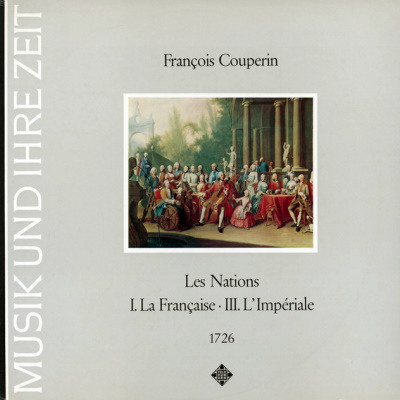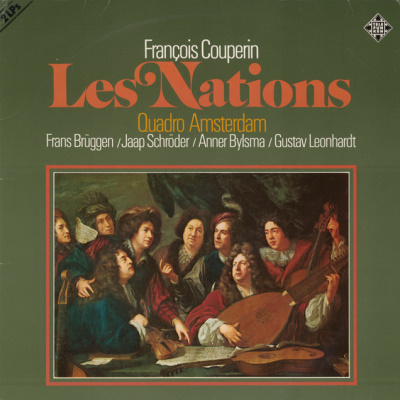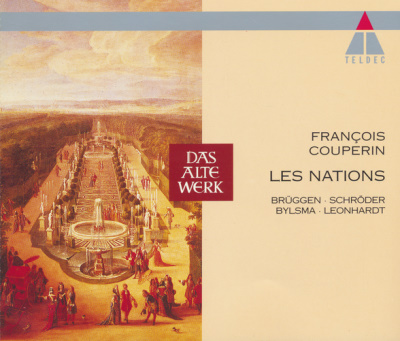 |
|
1 LP -
SAWT 9476-A - (p) 1965
|
 |
| 2 LPs -
6.48009 DX (TK 11550/1-2) - (p) 1969 |
 |
| 2 CD -
4509-93689-2 - (c) 1994 |
|
LES NATIONS
(1726)
Sonates et Suites de Symphonies en
Trio. En quatre Livres séparés pour la
commodité des Académies de Musique et
des Concerts particuliers. |
|
|
|
|
|
|
|
| François COUPERIN (1668-1733) |
Premier
ordre: La Française (E minor) |
|
24' 00" |
A |
|
-
(Sonate): Gravement · Gayement · Gravement
· Gayement · Gravement · Vivement · Air:
Gracieusement-Gayement
|
6' 23" |
|
|
|
- Allemande
|
3' 48" |
|
|
|
-
Première Courante
|
1' 40" |
|
|
|
-
Seconde Courante
|
1' 27" |
|
|
|
-
Sarabande |
1' 54" |
|
|
|
-
Gigue
|
1' 23" |
|
|
|
-
Chaconne ou Passacaille
|
3' 18" |
|
|
|
-
Gavotte
|
1' 06" |
|
|
|
-
Menuet |
1' 20" |
|
|
|
Troisième
ordre: L'Impériale (D minor) |
|
30' 00" |
B |
|
-
(Sonate): Gravement · Vivement ·
Gravement, et marqué · Légèrement ·
Rondement · Vivement |
10' 30" |
|
|
|
-
Allemande |
3' 06" |
|
|
|
-
Courante |
1' 56" |
|
|
|
-
Seconde Courante
|
1' 44" |
|
|
|
-
Sarabande |
1' 51" |
|
|
|
-
Bourrée |
0' 53" |
|
|
|
-
Gigue |
1' 04" |
|
|
|
-
Rondeau |
2' 07" |
|
|
|
-
Chaconne |
5' 13" |
|
|
|
-
Menuet |
1' 10" |
|
|
|
|
|
|
|
QUADRO AMSTERDAM
- Frans
Brüggen, Transverse
flute and Recorder
- Jaap Schröder, Violin
- Anner
Bylsma, Violoncello
- Gustav Leonhardt, harpsichord
with:
Marie
Leonhardt, Violin
Frans Vester, Flute
|
|
|
|
|
|
Luogo
e data di registrazione |
|
Studio Teldec,
Hamburg (Germany) - 31 Maggio / 3
Giugno 1965
|
|
|
Registrazione: live
/ studio |
|
studio |
|
|
Producer |
|
-
|
|
|
Prima Edizione LP |
|
Telefunken "Das Alte
Werk" | SAWT 9476-A | 1 LP -
durata 54' 00" | (p) 1965 | ANA
Telefunken |
6.48009 DX | 2 LPs - durata 54'
00" - 51' 21" | (p) 1969 | ANA |
Riedizione (Ordres I-II-III-IV)
|
|
|
Edizione CD |
|
Teldec Classics |
LC 6019 | 4509-93689-2 | 2 CDs -
durata 53' 06" - 51' 41" | (c)
1994 | ADD | (Produzioni
I-II-III-IV) |
|
|
Cover
|
|
"Picture of Joseph
III and family", painting by Peter
Jakob Horemans (original in
Schloss Nymphenburg). Photo: Erika
Drave
|
|
|
Note |
|
-
|
|
|
|
|
In
the preface
to “Les
Nations”,
Couperin relates how
“La Française”
came into being,
how it gained
early success as
a supposedly
Italian
composition, and
also the
principles on
which he
revised the
original
version. The
text of
the sonatas
themselves was
retained without
alteration
except for minor
details, but
each sonata had an extensive
suite added to it in the
printed version. The
composer’s development from
being a “serviteur passionné
d’Italie” (passionate
servant of Italy) to his
conscious attempt at a
“Réunion des goûts” (reunion
of tastes) manifests itself
quite clearly in
this late
combination of
an imported art
(the sonata)
with a
native one (the
suite). The
greatness of the
works, however,
lies largely
in the
fact that no
mere
juxtaposition of
French and
Italian elements
arose in
this process,
but a real blend
of the
two, even
in stylistic
details, so
that the
“réunion”
matured into a
harmonious
synthesis.
Italian melody
and harmony
and the
impressive
dignity of
broadly
conceived melody in
Corellian
adagios pervade
sonata and
suite movements
alike, blending
with the
traditional
French art of
embellishment,
with the
carefully worked-out
polyphonic and
quasi-poly
phonic structure of
the native chamber
music and with the French
spirit of “clarté” and
elegance to form an
entirely new
style. Spontaneity of
invention and
the greatest
subtlety of
structure are
here combined
with such
magnificence and
variety that it
would hardly seem an
exaggeration, in spite of
all stylistic differences,
to place Couperin’s trios
alongside the
chamber music of Bach.
The two works on this record
correspond to the pattern to
which Couperin adheres in
all his trio sonatas and
trio suites, without any
notable modifications. They
are written for two “dessus”
or descant
instruments that
are not
precisely stipulated
(violins or
flutes), which,
together with a
“basse d’archet”
(bass viol),
form a
trio of fully
worked-out
parts, supported
by the continuo
(which usually,
though not always,
follows the string
bass line). The
order of the movements
in the introductory
sonatas is
Corellian: usually
slow - quick fugato - slow -
quick dance movement -
slow - quick fugato -
air - quick dance
movement, the
individual
sections generally
leading into one
another without
a break.
This Italian
sonata is then
followed by the
French suite,
consisting of a
loose
arrangement of
dance movements
culminating in a grand
chaconne as the last
movement but one or two.
"La Française”
and “L’Impériale” show
most
impressively
what a
wealth of
nuances this
apparently rigid
formal scheme
left open
to a
master such
as Couperin.
At the same
time it should
be noted that
the imaginative
and colourful
titles of
the works - likewise
elements of the
French tradition - are not
programmatic in the narrow
sense of a concrete,
extra-musical “subject”.
They are to be
understood far more as
a “poetic”
embellishment and
as intentionally
vague references
to the style of
performance and the
basic musical
character,
designed to
stimulate the
imagination of
the performer and the
listener without
guiding them in any
too definite
direction. “La
Française” is
clearly
Corellian in
its opening - a
Grave whose
broadly spanned
Italian melody, full
of sighs and
suspensions, is
blended with
French rhythm and
ornamentation
into an elegiac
beauty. The Italian
nature of the sonata
remains clearly
evident throughout all its
movements, right
up to the
final Allegro -
a stylized Gigue
which, in its
concertante play
of motifs and
its delight in
thirds between
the upper parts, is
perhaps the
most Italian of
all the
short movements. The
suite that follows it
adheres strictly to the
traditional
French dance
types as regards
form, rhythm and
character of
expression, but
nevertheless combines
them with Italian
melodiousness of the upper
voices and Italian fullness
of sound in the compactly
homophonic
part-writing.
The centre-piece
of the
suite, its
large-scale Chaconne,
gathers up
within itself
all the
grandeur and
resplendent
dignity of
the French suite
tradition.
The interval of
more than thirty
years between
the composition
of “La Française” and
“L’Impériale” is
reflected in
the obvious
stylistic
individuality of
the later work,
even though
their basic
plans are
very similar.
The movement
forms have been
extended and
given greater
variety; the
traditional homophonic
and polyphonic types
of writing have
been modified by
a freer play of
motifs and
a mode of
writing varied
by concertante
effects. Subtle shades
of expression are
thus introduced
into the
individual movements
while, at
the same
time, their
basic characters are
more strongly
contrasted than
before. Italian and
French traditions are
here blended
into one style,
which begins
to break
up the traditional
forms, types and
modes of
writing from
within. In
its striving
towards a more
refined and
freer movement
structure, together
with the most varied and
most personal expression,
this new style
has already
left the
world of
the Baroque
and of Louis XIV
far behind. The tiny
Minuet that
concludes “L’Impériale”,
coming like a little
humorous
surprise after
the mighty
Chaconne, is
entirely
“galant” and
rococo in
character,
suggesting a
final glimpse
into the new age at
whose threshold Couperin in
his later works
had arrived.
Ludwig
Finscher
|
  |
|
|